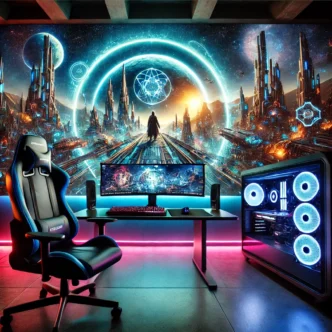Multiplayer gaming has come a long way since its early days, evolving from simple local connections to vast, interconnected global networks. This transformation has not only changed how we play games but also how we interact and connect with others. Here’s a look at the history of multiplayer gaming, highlighting its milestones and innovations.
The Birth of Multiplayer Gaming: The Early Days
The origins of multiplayer gaming can be traced back to the 1970s and 1980s, with games that allowed two players to compete on the same device.
- Pong (1972): One of the first multiplayer video games, where two players competed in a virtual table tennis match.
- Arcade Games: Games like Pac-Man and Street Fighter introduced competitive gaming in public arcades, fostering social interaction.
- Text-Based Multiplayer (MUDs): Multi-User Dungeons (MUDs) in the late 1970s enabled players to interact in text-based fantasy worlds over early computer networks.
The LAN Party Era: Local Multiplayer Takes Off
The 1990s saw the rise of Local Area Network (LAN) gaming, allowing players to connect multiple computers and play together in the same physical space.
- Doom (1993): Popularized LAN gaming by enabling players to connect and battle in real-time.
- StarCraft and Age of Empires: Strategy games became LAN party staples, fostering friendly competition and teamwork.
- Cultural Phenomenon: LAN parties became social events, where friends gathered to compete and collaborate over hours of intense gameplay.
The Dawn of Online Multiplayer
The advent of the internet in the late 1990s revolutionized multiplayer gaming, enabling players to connect beyond local networks.
- Quake (1996): One of the first games to support online multiplayer, introducing competitive first-person shooting over the internet.
- MMORPGs: Titles like EverQuest (1999) and World of Warcraft (2004) created massive online worlds, where thousands of players could collaborate and compete.
- Matchmaking Systems: Services like Xbox Live (2002) standardized online multiplayer, offering voice chat, leaderboards, and seamless matchmaking.
The Rise of Global Servers: Connecting the World
Modern multiplayer gaming has become a truly global phenomenon, with advances in technology enabling players from different continents to compete in real-time.
- Cloud Gaming: Platforms like Google Stadia and NVIDIA GeForce Now allow multiplayer games to run on remote servers, reducing hardware limitations.
- Esports: Competitive gaming has grown into a billion-dollar industry, with global tournaments like League of Legends Worlds and The International drawing millions of viewers.
- Cross-Platform Play: Games like Fortnite and Call of Duty: Warzone allow players on different devices to compete together, breaking platform barriers.
The Social Evolution of Multiplayer Gaming
Multiplayer gaming is no longer just about competition; it has become a social experience.
- Streaming and Communities: Platforms like Twitch and Discord foster communities where players share strategies, experiences, and friendships.
- Casual Multiplayer: Games like Among Us and Minecraft emphasize social interaction, making multiplayer gaming accessible to a broader audience.
- Virtual Reality (VR): VR multiplayer games like VRChat and Rec Room take social gaming to new immersive levels.
Challenges and Future of Multiplayer Gaming
As multiplayer gaming continues to evolve, it faces new challenges and opportunities:
- Cybersecurity: Protecting players from hacking and cheating remains a priority for developers.
- Toxicity in Gaming: Promoting positive and inclusive communities is critical for the future of multiplayer platforms.
- Technological Innovations: The integration of AI, 5G, and augmented reality will further enhance the multiplayer experience.
Multiplayer gaming has transformed from simple local matches to a global network connecting millions of players. As technology advances, the social, competitive, and immersive possibilities of multiplayer gaming are endless, promising an exciting future for gamers worldwide.













